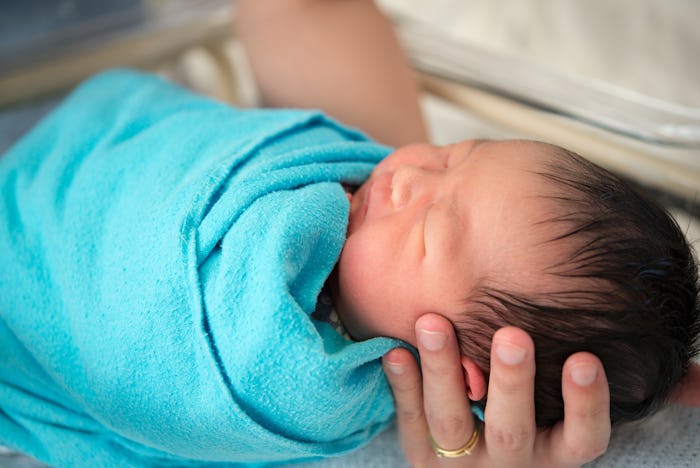Life

Here's When Your Baby Needs To Give Up The Swaddle
I think swaddling saved my marriage. (OK, this is a slight exaggeration, but still.) When my baby was first born, we struggled to soothe her, and those late night arguments really took a toll. So, I'm all for the practice of wrapping your baby up like a burrito, but because nothing good lasts forever, I remember wondering, when should you stop swaddling?
As new parents know, baby origami is one of the first things nurses try to teach your sleep-deprived self after you give birth. Your Baby's First Year Week by Week 3rd Edition (my own go-to baby book) noted that swaddling soothes your baby so effectively because it reminds her of her first home — your warm, confining belly. As a result, swaddled babies sleep longer and are less likely to startle.
Don't feel like you only need to swaddle at bedtime, either. Dr. Harvey Karp, author of Happiest Baby on the Block, noted on his website that swaddling can help you soothe a fussing baby by keeping her arms from wriggling (which might frighten her — she's still getting used to them) and imparting a sense of security. So what's not to love?
Unfortunately, swaddling is like Cinderella's slipper: its magic has an expiration date, and if the shoe no longer fits, you can't force it.
Romper spoke with Christine Stevens of Sleepy Tots Consulting, who cautions against swaddling babies once they start rolling. According to the American Academy of Pediatrics (AAP), swaddled babies that roll onto their bellies are at a "high risk of death." So, as soon as your infant starts to roll, or even show signs of trying, stop swaddling. Also, remember that a swaddled infant must always be placed on her back, according to AAP guidelines.
Stevens tells Romper that unless they've started rolling very early in life, "swaddling is wonderful for very young babies, up until about the ages of 10 to 12 weeks." After that, she maintains that swaddling can become a kind of prop — a crutch that may prevent your baby from learning to get to sleep on her own.
If your newborn struggles to fall asleep without swaddling, she suggests transitioning to an infant sleep sack or wearable blanket. Products like these offer a similar sense of confinement while still allowing for some movement.
In my own case, our baby told us when she didn't want to be swaddled anymore. OK, she didn't actually tell us, but at eight weeks, it was clear that swaddling had lost its luster. For one thing, she wanted the freedom to kick her heels super hard while lying in her bassinet (we still call this Baby Riverdance), and she was ready to meet her hands and arms at last.
If in doubt about how to safely swaddle your baby, or how long you should continue swaddling your infant, consult your pediatrician and remember this super-important rule: if baby is rolling, or even thinking about rolling, don't swaddle.